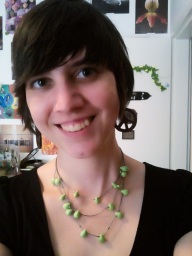The way I use technology to navigate my media degree changes every semester.
First semester I only owned a netbook and took it to uni each day to take notes and do work between classes. Anything that I needed actual computing power for (read anything more complicated than opening a web browser or tying an essay, I’m looking at you video and sound editing!) I had to do at uni in the computer labs. In second semester I bought a larger more powerful laptop to use at home and still took my netbook to uni for note-taking etc. Then all my editing was done at home on my laptop, which I used more like a desktop as it rarely moved.
This semester, my big laptop has died (I’m in the process of going through the warranty to get it repaired) and I’ve stopped taking my netbook to uni. I take my notes with a really nice pen in art sketch books and use my phone to take photos and blog about my lectures. I then sort of work on my video and sound editing at home on the netbook, but that’s driving me nuts.
Once my big laptop is fixed, I should be okay to use it for my editing work, but in fact I’ve grown to hate it over the last few months. It’s just not quite good enough for what I feel like I need to get through this degree. So, I’ve decided to invest in a new computer. Something that I can use to edit video that won’t make me want to rip my face off (nb- this is not an exaggeration, I feel like doing this sometimes when trying to load a program on my netbook for the twelfth time!).
My budget is $2000, and that has to include shipping, accessories and an extended warranty (preferably three years). This is more than double what I’ve spent of computers previously, but I’m now looking at this purchase as an investment in my education, so I’m taking it more seriously.
I see three options at this point.
- I can buy a nice, large screen laptop (either a Macbook or a PC) that will mostly stay at home and be used like a desktop, but that can be taken to uni if I really need to use it between classes or for group assignments.
- I can buy a nicer, larger screen iMac that doesn’t travel with me, but that does have a bigger screen (useful for editing, although I do have a very large TV that I can use an an external monitor if I don’t go with the iMac option…), is less likely to be damaged due to it’s lack-of-portability and has a bit more oomph in terms of processing power.
- I can buy an Asus Taichi 21, because it’s cool. Actually, it’d be handy because it’s portable enough to take to uni (and I could use the tablet function to take notes in lectures, much like I do with my art books now), but it’s also capable of editing videos and sound because of it’s processing power and ability to be a laptop as well as a tablet.
I’m leaning towards to Asus Taichi at the moment, partly because it is super cool and partly because as a media student, I feel like I should be one of the people out there testing the cool new things and coming up with innovative ways to incorporate them into my professional media practice. In this review of the Taichi, Steve Chippy Paine says:
“In all the years of testing mobile devices we’ve never struggled this hard to think of a target customer. The ASUS Taichi fits as a high-end presentation device, a first-class-cabin PC but mainly as food for thought.”
And as a media student, especially reflecting on the most recent Integrated Media lecture, I want to take that food-for-thought and do something cool with it. Something unexpected. Something amazing. But I’m worried that it won’t be the best tool to help me with my degree in general, no matter how cool it is or what I end up doing with it.
On the other hand, all the computers we use at uni are Macs and most students have Macbooks. It would be useful to be part of the Mac crowd for group assignments and for transferring my work to the computers at uni. And I really should learn how to use a mac instead of being surprised every time my fingers brush the touch pad and something new happens!
This morning I was all ready to purchase the Asus Taichi, but using my super power of restraint (which seems to have been granted to me today, as I usually just click that buy button…) I have decided not to make an impulse buy, but to weight up my options over the next few days and make a rational decision based on facts and not emotions. Holy smokes!
So, I’ve already asked my dad for advice (“Think about what you’re going to use it for, then buy something that fits your needs rather than your whims…”), and I’ve asked the RMIT media Facebook group, and now I’m asking you, my blog readers. If you were in my shoes, what would you go for? Actually, without being in my shoes, what would you go for for yourself? And why? I’m interested, so tell me in the comments…



